Sirex Woodwasp, European Woodwasp, European Horntail
Problem | History and Range | Identification | Biology | Signs and Symptoms | Damage in New York | Damage in the rest of the US | Management and Control | New York Distribution Map
Problem
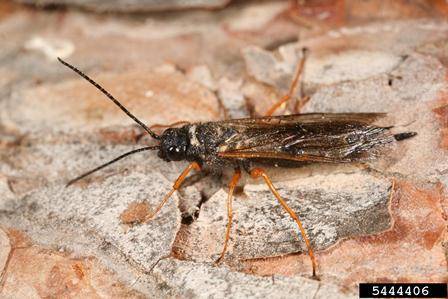
Sirex Woodwasp, Sirex noctilio, larvae are woodborers that tunnel deep into the trunks of all species of pine (Pinus) trees. As the female Sirex woodwasp, Sirex noctilio, prepares to lay her eggs, she secrets a toxic mucus and symbiotic fungus into the tree which work synergistically to weaken, and in some cases kill the attacked tree(s). The mucus creates a suitable environment for the fungus which decays the wood so it is easier for the larva to digest.
Sirex woodwasp has caused mortality of millions of North American pines planted In Southern Hemisphere forests, where Sirex Woodwasp (S. noctilio) is also an invasive species. Currently, Sirex woodwasp is estimated to cause between $16 and $60 million in annual damages per year in those forests.
In the US, southern and western native pine forests and plantations face both an economic and ecological threat with the potential loss of valuable pine stands. The USDA Forest Service estimates the Sirex woodwasp could cost between $2.8 and $17 billion in lost sawtimber and pulpwood values if it becomes a nationwide established species.
History and Range
The Sirex woodwasp, S. noctilio, is native to Europe, Asia and north Africa. It was first discovered in North America in 2004 in a trap in Fulton, NY (Oswego County). In its native habitat it is considered a secondary or minor pest. Where it has been introduced it is considered to be a major pest. In its native range S. noctilio attacks Scots (P. sylvestris) Austrian (P. nigra) and maritime (P. pinaster) pines and is known to attack North American pines including red (P. resinosa), loblolly (P. taeda), slash (P. ellotti), ponderosa (P. ponderosa), lodgepole (P. contorta) and Monterey (P. radiata). White pine (P. strobus) is also attacked but is less preferred.
Pines 6” and larger are susceptible, stressed, suppressed and crowded pines seem to be favored. It is thought that the Sirex woodwasp can spread approximately 25 miles per year.
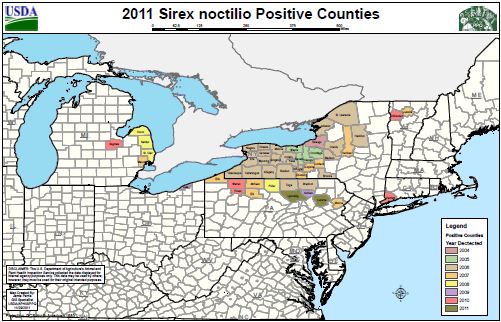
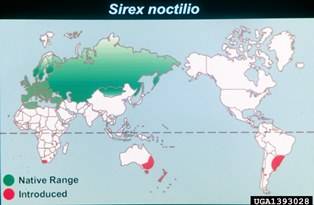
Identification
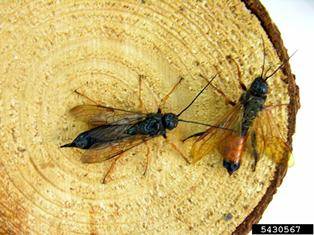
Adult Sirex woodwasp’s head and thorax are blue-black and have black antennae. Females have a blue-black abdomen with orange legs, while the abdomen of males has an orange mid-section and they have black hind legs. Woodwasps are 1 to 1.5 inches long and lack the typical narrow “waist” that most other wasps and hymenoptera have and there is a pointed plate that projects from the end of the abdomen.
There are many native woodwasps (Siricid woodwasps), and it is recommended to have a suspect woodwasp identified by an expert. Our native woodwasps only feed on dead and dying trees, while the Sirex woodwasp can also attack healthy trees. Images and descriptions of many Siricid woodwasps can be found in the Canadian Journal of Arthropod Identification “Siricidae (Hymenoptera: Symphyta: Siricoidea) of the Western Hemisphere” at http://www.biology.ualberta.ca/bsc/ejournal/sgsbws_21/sgsbws_21.html.
Larvae are 0.04 to 1 inch long, are creamy white and legless and have a spine at the end of their abdomen which is diagnostic for all woodwasps (also called horntails).
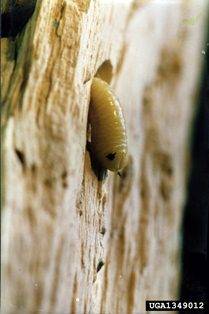
Biology
The female Sirex woodwasp injects her ovipositor into the trunk of a pine tree, just into the wood, and injects one egg at a time along with the symbiotic fungus, Amylostereum areolatum, and a toxic mucus. The toxic mucus suppresses the tree’s defenses and decreases the tree’s ability to protect itself from the wood decaying fungus. When the larva hatches, it feeds on the fungus decayed wood and enzymes, and possibly the fungus as well, as it bores through the wood. Females lay 25 to 400 eggs. Fertilized eggs become females and unfertilized eggs become males. Larvae feed in the tree for 10-11 months and then pupate near the bark. Adults emerge after three weeks. Peak adult emergence is in July, but can occur from July through September. There is believed to be one generation per year in New York.
Many of the specifics of Sirex woodwasp biology and the relationship between Sirex and the fungus are still unknown. Research is currently being conducted that will hopefully provide more detail on this fascinating insect and its associated toxic mucus and symbiotic fungus.
Signs and Symptoms
Infested trees initially wilt, needles droop, then change from green to light green to red. This usually takes 3-6 months. Wilted trees generally die within a year.
When adults emerge they bore a 1/8 to 3/8 inch round exit hole through the bark. Trees in newly infested areas have exit holes 10-30 feet above ground. In heavily infested areas, the whole trunk is utilized by the larvae and exit holes can be seen along its length. There may be lines of pitch or resin beads at oviposition (egg laying) sites.
In the wood, frass packed larval galleries tunnel in towards the heartwood and then loop back out towards the bark. The fungus causes a brownish stain in the outer sapwood.
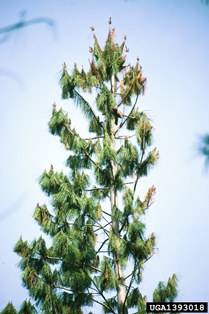
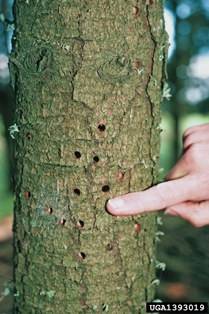


Damage in New York

In New York State the largest damage is being seen in plantation Scots, Austrian, and red pine. These plantations were planted in the early to mid-20th century and were often unmanaged and are now crowded, stressed and underperforming. The death of these underperforming trees is not having a large economic or environmental effect in New York.
Damage in the rest of the US
Whereas Sirex woodwasp damage in New York is not profound, Sirex Woodwasp damage has the potential to be much greater in the South and Pacific Northwest. The projected economic damage to these forests is upwards of $17 billion dollars with hundreds of thousands of trees lost.
To see maps of the potential damage to US pines click here. http://www.fs.fed.us/foresthealth/technology/invasives_sirexnoctilio_riskmaps.shtml
Management and Control
Biological control using a parasitic nematode, Deladenus siricidicola, has been successful in some infestations. The nematode infects the woodwasp larvae and ultimately sterilizes the females. These females lay infertile eggs that are instead filled with nematodes. As nematode populations grow, they can keep Sirex Woodwasp populations below damaging levels. Easy to rear in the lab, Deladenus siricidicola can be injected into infested trees. For more information about the lifecycle of Deladenus siricidicola see Cornell University’s Biological Control website: https://biocontrol.entomology.cornell.edu/pathogens/Deladenus.php
There are also parasitoid wasps, many native to North American, which could assist in managing Sirex woodwasp populations.
New York Distribution Map
This map shows confirmed observations (green points) submitted to the NYS Invasive Species Database. Absence of data does not necessarily mean absence of the species at that site, but that it has not been reported there. For more information, please visit iMapInvasives.



